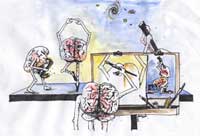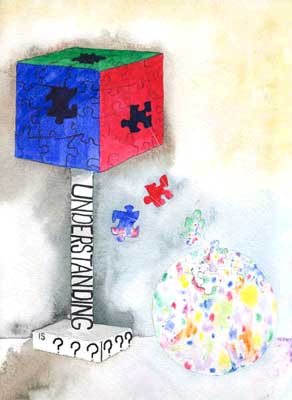FORUM 4
Thoughts on Color
Name: Gerald Wasserman
Username: Anonymous
Subject: Color
Date: 2002-07-24 11:47:35
Message Id: 2351
Comments:
Terrific multimedia presentation. One application in Biology would be having students bring in pages from magazines and newspapers and examine them under 40 or 100X of a light microscope.
Name: Tom
Username: mrwit@prodigy.net
Subject: Impressions
Date: 2002-07-24 11:51:09
Message Id: 2352
Comments:
I appreciated the explanations of additive and subtractive mixing of colors, and the relationship of both these phenomena to the perception of color. This will be most applicable to my biology classes (if any).
Name: RaMona Adams
Username: rwarner@ucwphilly.rr.com
Subject: Colors
Date: 2002-07-24 11:51:44
Message Id: 2353
Comments:
It was interesting to learn about colors and how different cultures perceive them. It seems as if the most important color distinctions are black and white hence, dark and light. This information could prove to be useful in the classroom social studies curriculum when teaching children about different cultures.
Name: Tom
Username: mrwit@prodigy.net
Subject: Application
Date: 2002-07-24 11:56:46
Message Id: 2354
Comments:
Though I've done it before, Ill be better able to relate the history of chemistry to the history of art and the history of philosophy. I'll also be better able to explain the determination of electron orbitals.
Name: Tom
Username: mrwit@prodigy.net
Subject: Application
Date: 2002-07-24 11:57:20
Message Id: 2355
Comments:
Though I've done it before, Ill be better able to relate the history of chemistry to the history of art and the history of philosophy. I'll also be better able to explain the determination of electron orbitals.
Name: Charles Foster
Username: cncfoster@hotmail.com
Subject: Color Response
Date: 2002-07-24 11:57:23
Message Id: 2356
Comments:
The presentation on color this morning may change the way I address colors with my students in the future. I don't think I would be discussing vectors because I'm an elementary science teacher. However, when I discuss prisms and rainbows I will try to incorporate some of the negative and additive color combinations. Alot of the other material would be more appropriate with older students.
Name: Randal
Username: kr092389@aol.com
Subject: Color Presentation
Date: 2002-07-24 11:59:07
Message Id: 2357
Comments:
I found it to be quite interesting that period and geography had such a large impact on the development of colors from a historical standpoint. A person's ability to express oneself artistically must have been somewhat constraining to an individual who sought to challenge existing conventions. Is there an accounting of "exploratory" works of art that were considered to be outside the norm for a particular period? And, how were these works of art treated by comtemporaries?
Applications
I would like to design some activities that utilize the custom color feature within PowerPoint to help students gain a better understanding of how our eyes use only three color receptors to assist the brain in making some color determination.
Name: carolyn fitchett
Username: carolynfc3@aol.com
Subject: color
Date: 2002-07-24 11:59:44
Message Id: 2358
Comments:
"Color", presented by Dr.Sharon Burgmayer was excellent, thought provoking , interactive and bridged curricular. I related the last portion (colors in different periods with paintings I see in various museums) as another reasons some paintings looks so, depressing in different time periods.
Her paintings and garden show an array of colors in and out of the spectrum.
I wished I had a color chart with me when I purchased carpet for a room Thursday. Color is important to me!
Name: Lois Mackey
Username: loismackey@yahoo.com
Subject: Morning Session: Reaction
Date: 2002-07-24 12:04:05
Message Id: 2359
Comments:
I enjoyed the mornig session on colors. I feel confident that I would be able to integrate a lot of the information for a science/art lessons for my students.Learning about the various format of coloring was a very interesting lesson that could lead into a history session. The students could aquire a lot more knowledge that could help them to be more active participate when going on a museum class trip.They could learned about the toxic compounds used when the various paintings were painted. The lessons could be adapted for any grade level.Over - all, very informative.
Name: S. Cooper
Username: sycooper@phila.K12.pa.us
Subject: Teaching Sci. in an intergrated manner: Color
Date: 2002-07-24 12:05:49
Message Id: 2360
Comments:
I enjoyed the presentation. Learning about color mixing was new to me.
I could see how it could be intergrated into a Scicence or math lesson at
the high school level. Elememtary students would be fascinated to see the various color changes using the overhead projector or slide presentation.
I think that it would move the children's thinking about color in a new direction.
Name: Marita Wagner
Username: Anonymous
Subject: color
Date: 2002-07-24 12:07:37
Message Id: 2362
Comments:
Even though we were exposed to the discussion of color last summer in the inquiry-oriented teaching of science institute my understanding became much clearer this time. I really liked the vector representation and Maxwell's triangle. The history of art and pigment development was also very interesting.
Name: carolyn fitchett
Username: carolynfc3@aol.com
Subject: COLOR
Date: 2002-07-24 12:11:34
Message Id: 2363
Comments:
"Color", in my classroom is not a major part of the curriculum. However, I have used colors with other activities discovering primary colors, mixing colors to discover other colors , afterimage and eye brain activities. But, now I will find out where "Color" ideally should be presented and what students should know in grade 6 according to 2061 Benchmarks.
Name: Tunde/ Tola
Username: Anonymous
Subject: Bridging colors.
Date: 2002-07-24 12:12:59
Message Id: 2364
Comments:
Initially we were wondering how colors could be related to the Institute, Bridging cultures and how this will apply to classroom experiences.
But from the presentation by Sharon we now understand that colors could be a whole world of wonders in the classroom. She touched on how colors could be related to diffrent cultures ranging from academic areas to cultural backgrounds.
APPLICATION:
Some of the students we teach respond to light reflections differently. As teachers we have to be sensitive to their various responses. In the case of a color blind student, he or she cannot discriminate the different lights' reflections accordingly.
Name:
Username: Anonymous
Subject: color/chemistry
Date: 2002-07-24 12:55:23
Message Id: 2365
Comments:
the lesson presented by sharon gave a different twist on teaching the mixture of colors and how it relates to chemistry.unfortunately i missed a small portion of the presentation but hopefully what i was able to gather from her lesson is that mixing of colors is basically a perception based on light. the primary colors are red,green,blue but when mixed you may get a range of colors.sharon spoke of colors that are not true colors such as magenta and yellow because of how the eye (cones) react to light. this could open up a number of classroom lessons related to colorblindness, a childs perception of color. interms of what age does a child distinguish color when its not through repetitive teaching? this type of subject could be used throughout the curriculum in all subject areas.in addition this could be a great senior project or serive learning component for elem-high school.
Name: Anne Dalke
Username: adalke@brynmawr.edu
Subject: evolution of color
Date: 2002-07-24 13:14:09
Message Id: 2366
Comments:
Kaye Edwards and I, who will be doing the next two presentations in the Institute, sat in on Sharon Burgmayer's session this morning, and reveled in the visual feast she'd prepared for us--it made me realize how limited my own palette is, how limited my understanding of color and how it "works." Talking afterwards, Kaye and I also found ourselves wondering
--do animals have the same cones/see the same colors we do?
(if so, why, why not?) if fewer, are they a subset of ours? if different, well...what are they? (how can we know?)
--why are our receptors for red/green/blue? it's curious to me, for instance, that they aren't evenly spaced across the color spectrum...so: do those/did those particular colors serve some use-function @ some time in evolutionary history?
--Sharon mentioned to me afterwards that some (few?) people have a 4th cone/receptor...is this a futher step in evolution? what does the world look like to them? do they have a more nuanced...palette? can they...paint what they see?
Name: Paul Grobstein
Username: pgrobste@brynmawr.edu
Subject: Color vision ???
Date: 2002-07-24 14:46:31
Message Id: 2367
Comments:
Nice questions, Anne and Kaye, less easy to answer in a few words or (of course) definitively.
No, not all animals have the same cones. In fact, many animals have no cones at all, only rods. Those are noctural animals, whose eyes are adapted for low light conditions. By surveying percentages and distributions of rods and cones in different animals, one can make a pretty strong argument that cones evolved specifically to make possible good vision in daylight, and only secondarily made possible "color vision".
Different animals have different numbers of cones, and no, they are not necessarily a subset of ours. In fact, there is, at the moment, no generally accepted reason for why our three cones have the sensitivities they do (long, medium, and short, NOT "red", "blue", and "green"). There seems to be more than a little arbitrariness/randomness in this (as for much else in evolution). What's critical for wavelength discrimination is not "even spacing" but rather any spacing that assures that at least two cones overlap with different sensitivities at each wavenlength.
Some women may indeed have a 4th cone receptor, for reasons having to do with the phenomenon of X inactivation (one X chromosome in each female's cell is inactivated, with the choice of which being random and different for each cell). It doesn't produce a dramatic difference in palette, indeed its hard to be sure because it doesn't (cf. Looking for Madam Tetrachromat.
LOTS of stuff on the web related to these subjects. For an overview on animal variation see Vision in Early Mammals.
Hope this helps, one way or another.




